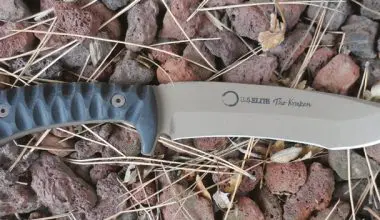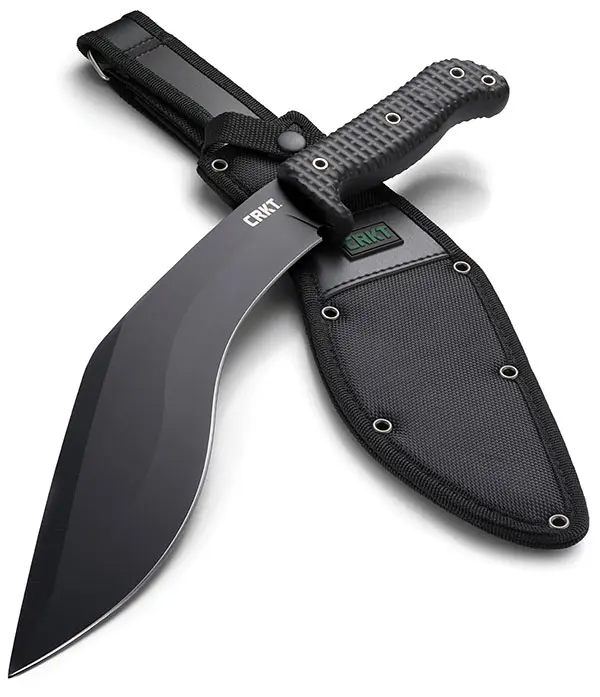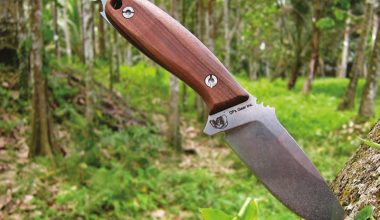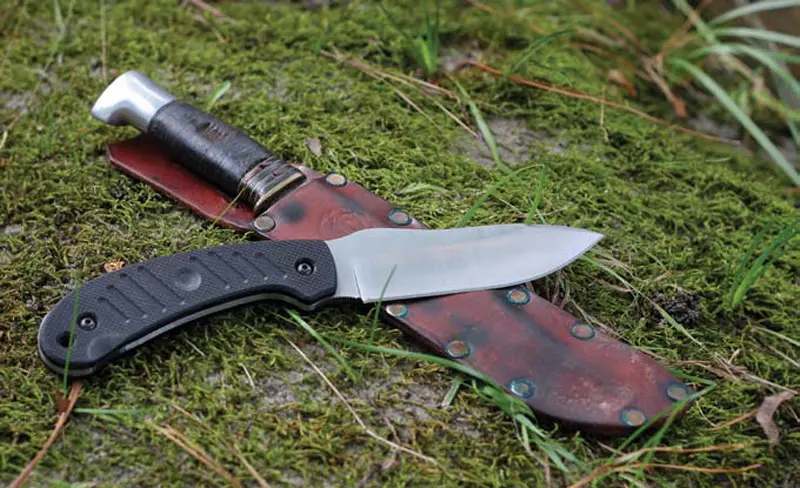
The N’yati was designed as an African bush knife, suitable on safari for tasks from routine chores to skinning out the mighty cape buffalo that it’s named for.
Tim Wegner, founder of Blade- Tech Industries and the designer of the N’yati, is an avid African hunter and knows a thing or two about using a blade in camp. The knife’s fiveinch blade has a unique spear-point shape that allows the user to choke up differently depending on the job, and in each case the hand finds the blade in the perfect place to work. Whether cutting deep—as in creating an improvised tent pole from a limb—slicing food or doing detailed skinning with the tip of the blade, the hand is in a comfortable position to cut well and safely, thanks to the deep finger choil.
There are serrations in key areas of the tang and the back of the blade that Wegner had ground to both enhance grip, but more importantly to help the user keep the knife oriented correctly when working inside a large animal in fading light with blood-slick hands.
Many S.W.A.T. readers are probably mildly interested, thinking that’s nice, but … I’m not going to Africa. Don’t let the laser-engraved buffalo or the knife’s original purpose distract you: this is a superb tactical knife.
It’s worth recalling that the frontiersmen of our West did a lot of fighting with the camp and skinning knives of their day—the Green River knives. While some regions saw dedicated dirks or fighting Bowies, a lot of the real work as back-up weapons fell to the skinning and camp knives, just as the KaBars and Marble’s Ideal camp knives served the greatest generation in World War II. The N’yati may very well be the idealized Green River knife of this age.
Once in hand, there is an immediate sense of what the N’yati could do as a weapon. Whether in a saber grip or reversed, it feels like a fighter. Wegner is distinctly aware of this and even added serrations near the butt to aid in a reverse grip.
Some fixed-blade fighting knives immediately evoke a certain use in the hand: it’s hard to grip a Strider DB-L and not think of short, wicked thrusts in tight; while a Randall 1-7 suggests certain cuts and saber-like thrusts. Neither example jumps out as an all-around utility blade. The N’yati feels immediately useful, with the G10 scales nestling into the palm to suggest a worthy companion whether in camp or in a bad fight.
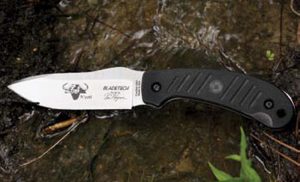
The knife is American made with a 5/32” thick S30 V Crucible steel blade flat ground to an astonishingly sharp edge. The blade is just thick enough to suggest serious strength, but thin and ground flat enough to reduce drag and slice well.
For years, my unscientific test of sharpness has been to take an old section of parachute cord and draw the length of the blade perpendicularly across it, with only light index finger pressure atop the back of the blade. Most factory knives slice about halfway through the braided fiber shell and may cut some of the inner string running through the cord “tube.” A few standout knives get most of the inner strings. The N’yati neatly sliced all the way to the other side, leaving only a tiny strand connecting the cord. It is wicked sharp.

Overall length is 8.5”, large without being impractical. I’m a sucker for big knives, having chosen a profession where I could carry one, but time after time I find the knives I actually carry to be in the five- to six-inch blade range. The N’yati fits perfectly on a pistol belt or attached to armor. I’ve been running the test knife adjacent to my rifle magazine pouches, and it is immediately available to either hand without being in the way of the carbine or any normal motion/activities.
Many otherwise great knives have disappointing sheaths and require a custom sheath purchase or settling for poor transport. You would reasonably expect that Blade-Tech would have a first-rate Kydex sheath, and that is indeed the case. Retention is molded to be positive, but is unlike some that are obnoxious and have the user tugging mightily and endangering everyone within reach when the sheath finally releases the blade to come flying out.
There’s no need for snaps or straps, and the sheath is trim but has mounting holes for Chicago screws to mount in a variety of possible angles to a TEK-LOK or a MOLLE-LOK. The sheath can as easily be lashed or cable tied wherever needed.
At only eight ounces, the N’yati is light enough for full-time belt carry and is in the sweet spot of length that allows a wide variety of tasks to be accomplished.
The blade is quite reflective, which could be a concern for those using it as a tactical knife. I may break out the Krylon before deployment to address that, but the N’yati is definitely coming with me.
